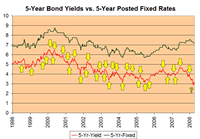 People who closely track fixed mortgage rates always have an eye on bond yields. That’s because bond yields are a key benchmark that lenders use to set fixed rates.
People who closely track fixed mortgage rates always have an eye on bond yields. That’s because bond yields are a key benchmark that lenders use to set fixed rates.
It’s not surprising then, that bond yields very often lead fixed mortgage rates. Yellow arrows on the chart above show some of the times over the last 10 years when bonds have led an increase or decrease in fixed rates by one week or more. As the chart illustrates (click to enlarge), bond yields are a fairly good short-term predictor.
Keep two things in mind, however. Bonds are volatile by nature and are not foolproof indicators. You will sometimes get headfakes where bonds move 1/4% or more but fixed rates don’t follow.
Second, if there’s any predictive power to bond yields, it is very short term. Predicting rates a few months out is still a pure gamble much of the time. That’s due to the infinite unforseen variables that affect bond prices long-term.
As an aside, there’s also a few other anecdotal points of note about this chart. For one thing, as you can see, bond yields haven’t been this low for a very long time. Actually, they haven’t been this low for as long as we have bond data.
Second, the last time bond yields fell this much, this fast, was in 2001–the start of the last U.S. recession. Rates continued to trend lower for 3 1/2 years after.
Will that happen this time around? Who knows. If folks like CIBC’s Benjamin Tal are right about inflation concerns in 2009, it won’t.
For now, though, the Bank of Canada believes inflation is in check.
Data Source: Bank of Canada



One more thing of note…
Crystal balls (that work) are exceedingly rare in this business. Being able to predict short-term changes to fixed rates in no way increase one’s odds of “beating the market” over a one to five-year term.
In general, the simple act of choosing a variable rate-mortgage will outperform virtually all fixed-rate market timing strategies.
Rob